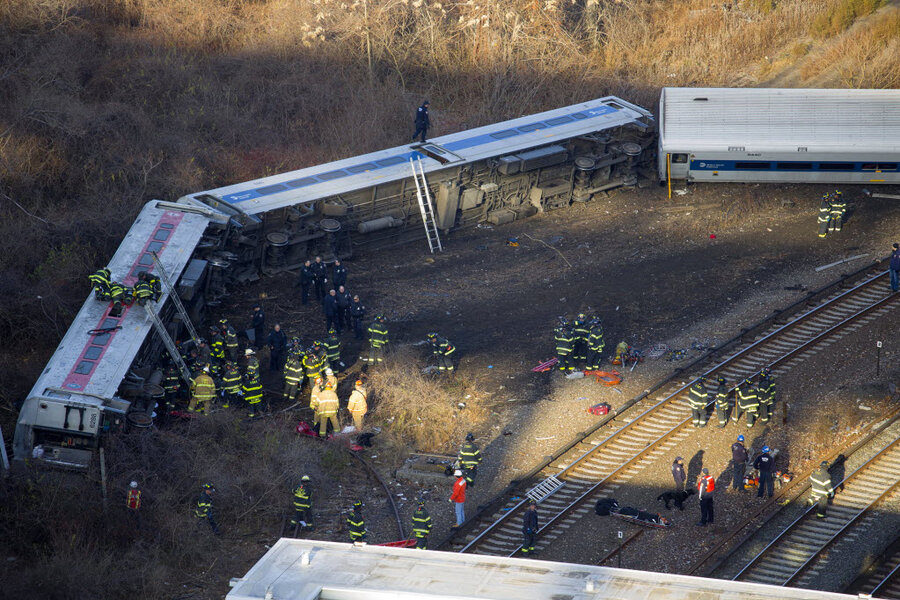4 dead, 63 injured in Metro-North train derailment in Bronx
Loading...
| New York
A Metro-North passenger train derailed on a curved section of track in the Bronx on Sunday morning, killing four people and injuring 63 as it came to rest just inches from the water, authorities said.
New York Gov. Andrew Cuomo announced the deaths at a news conference at the site of the crash near the Spuyten Duyvil station. He said authorities believe everyone at the site has been accounted for and that investigators from the National Transportation Safety Board are en route.
Three of the dead were found outside the train, and one was found inside, authorities said. Their families haven't yet been notified.
Eleven people are believed to be in critical condition, authorities said. The train operator was among the dozens injured, Cuomo said.
Metropolitan Transportation Authority spokeswoman Marjorie Anders said the big curve where the derailment occurred is in a slow speed area. The black box should be able to tell how fast the train was traveling, Anders said.
The derailment of the southbound Hudson Line train was reported at about 7:20 a.m., authorities said. The train left the town of Poughkeepsie at 5:54 a.m. and was due to arrive at 7:43 a.m. at Grand Central Terminal in midtown Manhattan.
Four or five cars on the seven-car train derailed about 100 yards north of the station, the Metropolitan Transportation Authority said in a news release. But none of the cars entered the Hudson or Harlem rivers, which are adjacent, the MTA said.
The train appeared to be going "a lot faster" than usual as it approached the curve coming into the station, passenger Frank Tatulli told WABC-TV.
MTA Chairman Thomas F. Prendergast was asked at the news conference if speed was something authorities planned to investigate.
"That'd be one of the factors," he said, adding that the focus right now was on the passengers who were injured.
Joel Zaritsky told The Associated Press he was on his way to New York City for a dental convention.
"I was asleep and I woke up when the car started rolling several times. Then I saw the gravel coming at me, and I heard people screaming. There was smoke everywhere and debris. People were thrown to the other side of the train," he said, holding his bloody right hand.
Passengers were taken off the derailed train, with dozens of them injured, holding ice packs to their heads.
The Fire Department of New York said 130 firefighters had responded to the derailment.
The crash was reported by the engineer, and it wasn't clear if any other crew members were among the injured, the MTA said.
Edwin Valero was in an apartment building above the accident scene when the train derailed. He said none of the cars entered the water, but at least one ended up a few feet from the edge.
At first, he said, he didn't notice that the train had flipped over.
"I didn't realize it had been turned over until I saw a firefighter walking on the window," he said.
Amtrak Empire service was halted between New York City and Albany after the derailment. Amtrak said its Northeast Corridor service between Boston and Washington was unaffected.
Prendergast said that when the NTSB gives them the go-ahead, they will begin efforts to restore service.
On May 17, an eastbound train derailed in Bridgeport, Connecticut, and was struck by a westbound train. The crash injured 73 passengers, two engineers and a conductor. Eleven days later, track foreman Robert Luden was struck and killed by a train in West Haven, Connecticut.
Earlier this month, Metro-North's chief engineer, Robert Puciloski, told members of the NTSB investigating the May derailment and Ludent's death that the railroad is "behind in several areas," including a five-year schedule of cyclical maintenance that had not been conducted in the area of the Bridgeport derailment since 2005.
The NTSB issued an urgent recommendation to Metro-North that it use "redundant protection" such as a procedure known as "shunting" in which crews attach a device to the rail in a work zone alerting the dispatcher to inform approaching trains to stop.







